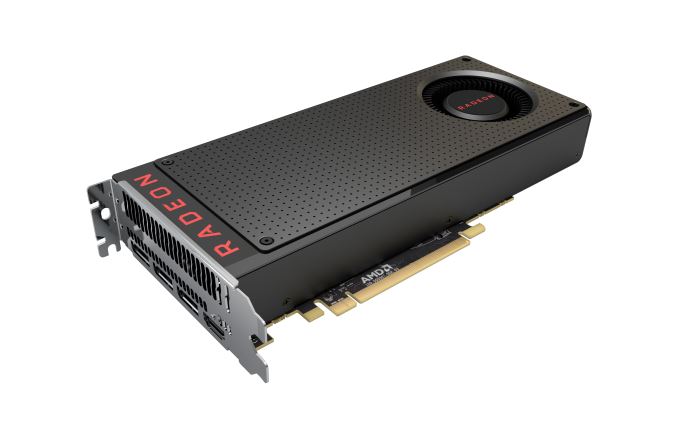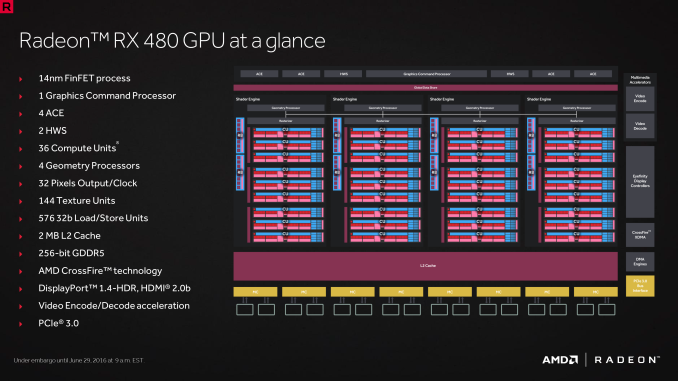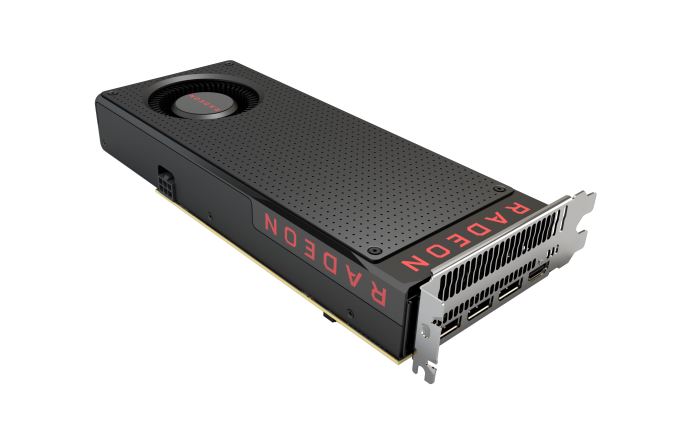The AMD Radeon RX 480 Preview: Polaris Makes Its Mainstream Mark
by Ryan Smith on June 29, 2016 9:00 AM EST
Back in December of last year, AMD’s Radeon Technologies Group began slowly trickling out the plans for what would be their first GPU architecture built for the now-modern FinFET processes: Polaris. As part of a broader change in how GPU architectures have been handled – more information is now released ahead of launch – AMD laid out what they wanted to do with Polaris. Aim for the mainstream, radically improve power efficiency, lay the groundwork for HDR displays, and, of course, improve performance.
Now six months later we are seeing AMD’s plans come to fruition, as the Polaris GPUs are in full production, and the first retail products are launching today. Kicking off the Polaris generation in the desktop market will be AMD’s Radeon RX 480, which is aiming for the mainstream market. We’ve already seen the card, the price, and AMD’s marketing spiel back at Computex 2016, so now it’s time to take a look at the final, retail hardware.
| AMD Radeon GPU Specification Comparison | ||||||
| AMD Radeon RX 480 (8GB) | AMD Radeon RX 480 (4GB) | AMD Radeon R9 390 | AMD Radeon R9 380 | |||
| Stream Processors | 2304 (36 CUs) |
2560 (40 CUs) |
1792 (28 CUs) |
|||
| Texture Units | 144 | 160 | 112 | |||
| ROPs | 32 | 64 | 32 | |||
| Base Clock | 1120MHz | N/A | N/A | |||
| Boost Clock | 1266MHz | 1000MHz | 970MHz | |||
| Memory Clock | 7-8 Gbps GDDR5 | 7Gbps GDDR5 | 5Gbps GDDR5 | 5.5Gbps GDDR5 | ||
| Memory Bus Width | 256-bit | 512-bit | 256-bit | |||
| VRAM | 8GB | 4GB | 8GB | 2GB | ||
| Transistor Count | 5.7B | 6.2B | 5.0B | |||
| Typical Board Power | 150W | 275W | 190W | |||
| Manufacturing Process | GloFo 14nm FinFET | TSMC 28nm | TSMC 28nm | |||
| Architecture | GCN 4 | GCN 1.1 | GCN 1.2 | |||
| GPU | Polaris 10 | Hawaii | Tonga | |||
| Launch Date | 06/29/16 | 06/18/15 | 06/18/15 | |||
| Launch Price | $239 | $199 | $329 | $199 | ||
At the highest level, the RX 480 is based off of a fully enabled version of AMD’s Polaris 10 GPU. This is the first Polaris GPU to hit the market, and is the larger of the two GPUs. The total transistor count is 5.7 billion, which takes up 232mm2 on GlobalFoundries’ 14nm FinFET process. That this GPU is built at GloFo and not TSMC is a significant departure for AMD, who previously has used partner TSMC just shy of forever, and is the first time AMD and NVIDIA haven’t used the same fab in some 13 years. We’ll touch upon the foundry issue more in the full review, but the important thing to take away right now is that with the split in foundries, it’s no longer architecture alone that dictates whether a given NVIDIA or AMD GPU is better; process now plays a part, and the playing field is no longer even.
As it’s using a full Polaris 10 GPU, the RX 480 ships with all 36 CUs (2304 SPs) enabled. Ignoring architectural efficiency for the moment, this puts it somewhere between the Radeon R9 390 (Hawaii) and Radeon R9 380 (Tonga) in terms of CU count, with AMD having spent a good chunk of their 14nm density gains on adding CUs. Note that the CUs themselves have not substantially changed – it’s still 64 stream processors and 4 texture units per CU – which is where the 144 texture unit counts comes from.
On the backend of things, RX 480 is equipped with 32 ROPs. This is fewer than Hawaii’s 64 ROPs, but it is consistent with mainstream parts, as ROP needs don’t scale nearly as quickly from one generation to the next like compute (CU) needs. These 32 ROPs are paired with 2MB of L2 cache, which is twice as much L2 cache per ROP as the bulk of AMD’s last-gen lineup. The increased L2 cache has a die space cost – which is now easier to pay with the 14nm process – and helps to improve performance and cut power consumption by keeping more data on-die.
However once you go off-die, you will run into RX 480’s VRAM, which is a small story in and of itself. Once again common for mainstream AMD cards, AMD has stuck with a 256-bit GDDR5 memory bus here. Attached to this bus is either 4GB or 8GB of VRAM, with AMD offering two capacities for RX 480. The reason for offering multiple capacities is that AMD wants to hit the $199 price point with the card – the traditional sweet spot for mainstream cards – which would be hard to do with an 8GB card at this time. By offering both, AMD can hit that price while offering a full 8GB card at a slightly higher price for buyers with a bit more flexibility and/or greater VRAM needs.
Where things get tricky here however is the memory speeds. Officially, 7Gbps GDDR5 is the minimum speed for both RX 480 capacities, and this is the speed that AMD’s 4GB reference card runs at. However for their 8GB reference card, AMD has opted to ship the card with faster 8Gbps memory in order to further boost performance. I suspect that AMD would have liked to have used 8Gbps memory throughout, but the aforementioned price target required AMD to make some concessions to comfortably reach it. Otherwise for the higher priced 8GB card, AMD didn’t need to pinch pennies, and as a result they were able to ship it with 8Gbps memory.
| AMD Radeon RX480 Memory Bandwidth | |||||
| AMD Radeon RX 480 8GB Reference | AMD Radeon RX 480 4GB Reference | AMD Radeon RX 480 Min Requirements | |||
| Memory Clock | 8Gbps GDDR5 | 7Gbps GDDR5 | 7Gbps GDDR5 | ||
| Memory Bus Width | 256-bit | 256-bit | 256-bit | ||
| Total Mem Bandwidth | 256GB/sec | 224GB/sec | 224GB/sec | ||
| VRAM | 8GB | 4GB | 4/8GB | ||
The end result is that we have an odd schism between AMD’s card requirements and what they actually ship. The reference 4GB RX 480 meets the RX 480 minimum specifications, whereas the reference 8GB card is de facto overclocked relative to those same specifications. As we’ll see in our benchmark results, the difference in performance isn’t too great, but I don’t think this is an ideal outcome for consumers. My biggest concern right now is what happens when AMD’s partners start shipping their custom cards; if they opt for slower memory buses, then this would mean that custom 8GB cards could end up slightly underperforming the official reference card. But we’ll have to see how that plays out.
Moving on, let’s talk about power consumption. As AMD has made clear over the last several months, one of the major goals of Polaris was power efficiency, and this is where we see some of the first payoffs from that decision. RX 480’s official Typical Board Power (TBP) is 150W, over 20% lower than the last-generation R9 380, and 45% lower than the otherwise performance-comparable R9 390. Consequently the card only requires a single 6-pin PCIe power connector for external power, making it a more friendly option for power-limited desktops that don’t offer additional power connectors.
In terms of design, the reference RX 480 is a double-wide, blower-style card measuring 9.5-inches long. Notably, this is the first AMD retail reference card since the Radeon R9 290 series to use a blower, giving AMD the opportunity to show that they’ve learned from 290’s excesses and that the company can build a better blower. Given AMD’s mainstream ambitions, a blower makes a lot of sense for a $199, 150W card, as a fully exhausting card is going to be the most compatible with the wide variety of desktop designs out there. AMD doesn’t need to worry about whether the cooling built into the chassis can handle 150W of heat, since the card can remove the vast majority of the heat on its own. The blower design does add some length to the card though; the PCB is only 7-inches long, while the space requirements for the radial fan push the card out to the full 9.5-inches.
For connectivity, buyers will find 3 DisplayPorts and an HDMI port; AMD has done away with the DVI port for their reference design. As this is a new card on a new architecture, both port types support their latest respective standards. For DisplayPort this means support for the 1.3 and 1.4 standards, adding the newest, fastest HBR3 signaling mode, along with full HDR support. Meanwhile for the HDMI support, HDMI 2.0b is supported, offering 4Kp60 support with HDR.
For today’s launch, this is going to be a full reference launch. All of AMD’s partners are shipping AMD’s reference design in 4GB and 8GB capacities, which means the differences between the vendors will come down to pack-in items, support, and whether anyone charges a premium for the aforementioned items. Card availability is said to be good, but at this point I’m going to be surprised if most retailers don’t sell out by the end of the day, as these days it’s rare for video cards not to sell out, even mainstream cards. Looking at the slightly longer term, AMD isn’t able to state exactly when we’ll see custom RX 480 boards hit the market, but from what I gather it will be sooner rather than later.
Moving on, with two different capacities there are two different prices for the RX 480. The entry level 4GB card will be launching at the previously unveiled price of $199. Meanwhile the 8GB card will launch at $239, a $40 price premium for the extra 4GB of memory and the higher memory frequency. I do not have a good idea of what the split is between 4GB and 8GB cards, but I suspect that it will be the 8GB cards that are more plentiful.
Finally, looking at the competitive landscape, just as was the case last month with NVIDIA’s GTX 1000 series and the high-end market, the Radeon RX 480 series is launching uncontested into the mainstream market. At least for the time being all of NVIDIA’s products are positioned well above the RX 480 – with GTX 1070 starting at $399 – which means what competition there is for AMD is composed of last-generation 28nm cards, particularly the GTX 970 and GTX 960. As these are last-generation cards, neither one is strictly comparable to the RX 480, and in the long run these cards have a limited shelf life as they’re due to be discontinued sooner than later.
| Summer 2016 GPU Pricing Comparison | |||||
| AMD | Price | NVIDIA | |||
| $659 | GeForce GTX 1080 | ||||
| $429 | GeForce GTX 1070 | ||||
| Radeon R9 390X | $329 | ||||
| $259 | GeForce GTX 970 | ||||
| Radeon RX 480 (8GB) | $239 | ||||
| Radeon RX 480 (4GB) | $199 | ||||












449 Comments
View All Comments
ffleader1 - Thursday, June 30, 2016 - link
Can you maybe redo the test with updated driver.It seems that newer driver really makes a HUGE difference.
https://www.reddit.com/r/Amd/comments/4qiffg/rx_48...
Ryan Smith - Friday, July 1, 2016 - link
This was done with the latest driver to begin with: 16.6.2. The press was not distributed any other driver AFAIK.Falko83 - Thursday, June 30, 2016 - link
I hope that in the review you can also address 1080p 144hz gaming.davide445 - Thursday, June 30, 2016 - link
"Relative to last-generation mainstream cards like the GTX 960 or the Radeon R9 380, with the Radeon RX 480 we’re looking at performance gains anywhere between 45% and 70%, depending on the card, the games, and the memory configuration. As the mainstream market was last refreshed less than 18 months ago, the RX 480 generally isn’t enough to justify an upgrade"This is something I didn't understand. 45-70% performance increase it's not enough for a card that request less power and cost less?
Also where is the problem with the fact the power consumption is above equivalent Nvidia? At 150w I doubt anyone upgrading need a new PSU. I suppose below a threshold power request it's not part of the game anymore, otherwise next request will be that a GPU will produce power and not need some....
dragonsqrrl - Thursday, June 30, 2016 - link
Ryan addressed some of this in response to an earlier comment:"Although it's not an objective metric, generally I'm looking for an average 65%+ performance increase to justify replacing a video card. Against 380 in particular, 480 doesn't quite reach that mark."
150W TDP wouldn't be a problem in a vacuum, but unfortunately AMD is competing against Nvidia, not just at the midrange, but the whole product stack including the high-end. That means AMD is going to have more trouble scaling performance this coming generation, not unlike the last. In modern microarchitectures performance and efficiency are basically the same thing because we've hit the TDP ceiling for these form factors. I think Ryan actually explained it quite elegantly:
"power efficiency and overall performance are two sides of the same coin. There are practical limits for how much power can be dissipated in different card form factors, so the greater the efficiency, the greater the performance at a specific form factor. This aspect is even more important in the notebook space, where GPUs are at the mercy of limited cooling and there is a hard ceiling on heat dissipation."
davide445 - Thursday, June 30, 2016 - link
Maybe I'm asking too much objectivity. Asking for +65% for performance increase is nothing without a specific reason. 960 vs 760 show a 6% increase in 3dmark performances.760 vs 660 show a 20% increase. 660 vs 560 show a 55% increase (data from GPU boss). So why a 40-70% (average 55%) is not enough? It's the same you can achieve with two generations of Nvidia equivalent.About TDP ok for competing, but what I'm saying is it's not more relevant. Ok when AMD GPU was 200-250w hungry and Nvidia equivalent was 100w less, but with 150w really make difference for anyone for maybe 50w? Also didn't understand about the whole stack competition, we need to compare same price level: 480 vs 380 or 390 or 960 or 970, 1070 is available on Newegg for $430 min, 1060 is not available at all.
dragonsqrrl - Thursday, June 30, 2016 - link
It sounds like you're under the impression he recommended upgrading from a 760 to a 960, he did not."Also didn't understand about the whole stack competition"
Then am I correct in assuming you don't understand the significance of TDP ceilings for a given form factor? If you have a less efficient architecture, you're going to have a less performant GPU once you approach that ceiling. It's not as concrete for desktop discrete GPUs as it is for notebooks, but there are still upper limits, which tend to be around 250-300W. AMD can always price competitively, but the last thing they need right now is a repeat of last gen. They need competitive 'products' in their lineup, and for AMD, in terms of financial and competitive viability, that means a lot more than just price/performance ratios. This has less to do with the RX480 right now and more to do with prospects for the rest of the generation.
Ananke - Thursday, June 30, 2016 - link
Let me simplify for you: The question is "What can I get for $200?". RX480, RX380, GT960, GT950.Very simple choice at the moment.
dragonsqrrl - Thursday, June 30, 2016 - link
@AnankeYes, yes it is. But if you read the last sentence in my previous comment, and the rest of my responses the the thread, you'd hopefully realize that's besides the point.
davide445 - Thursday, June 30, 2016 - link
I suppose depends what these reviews are expected for. IMHO (and of course this is my personal opinion) these need to be guides useful for informed purchase, similar to what you did expect from stock investment advice. So you need to be specific about your assumptions and audience.These cards are not for mobile, so mobile is not in the equation. We are discussing about a specific card, not a corporate or tech startegy. We are discussing about mostly gaming or DX performances, so the audience are using a PC and didn't consider enough integrated GPU. So need to decide mostly if upgrade, not to purchase the first one considering how PC market is going. So the decision this review need to address is what GPU on the market this people need to purchase, considering a target price and average PC specs.